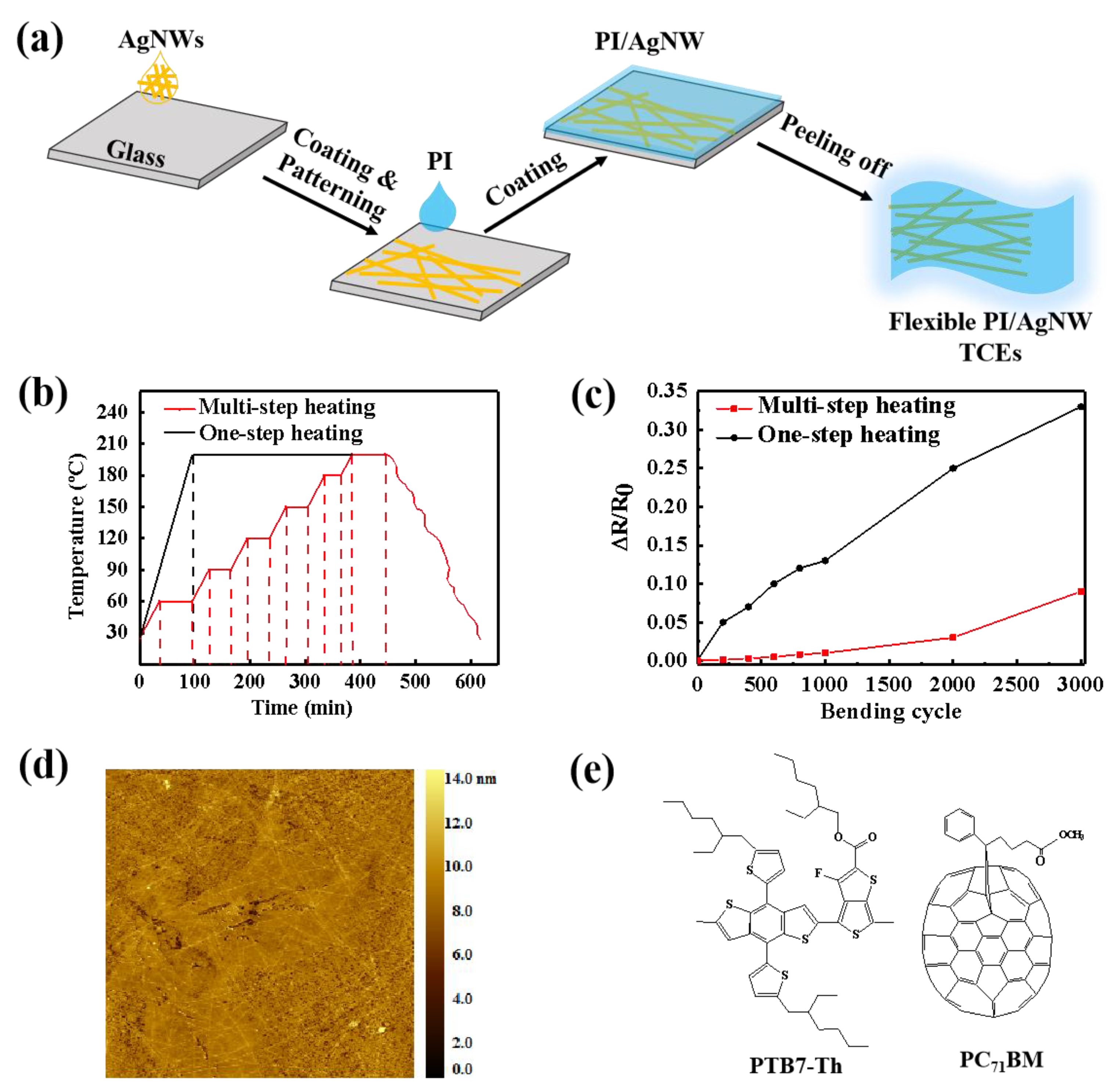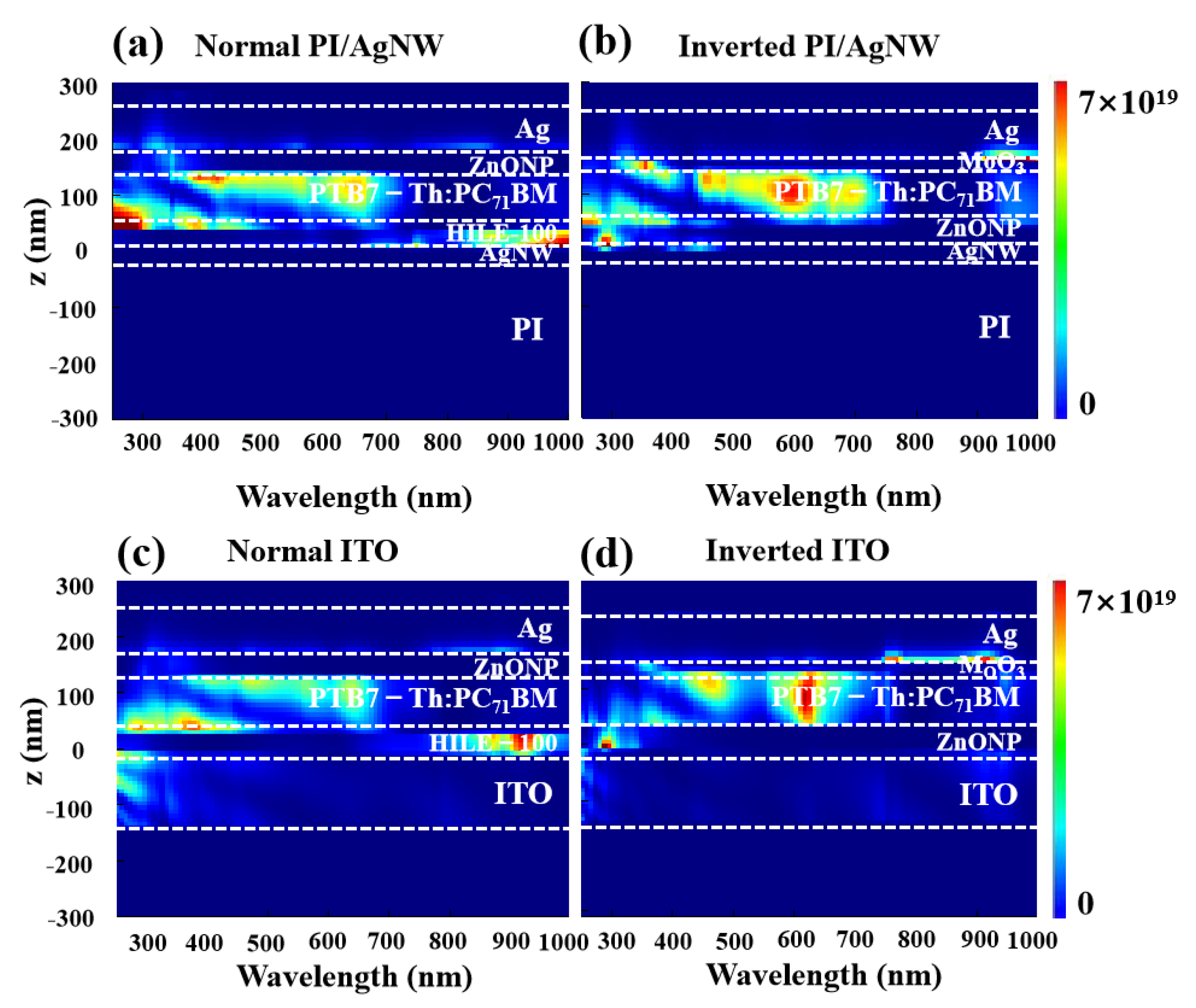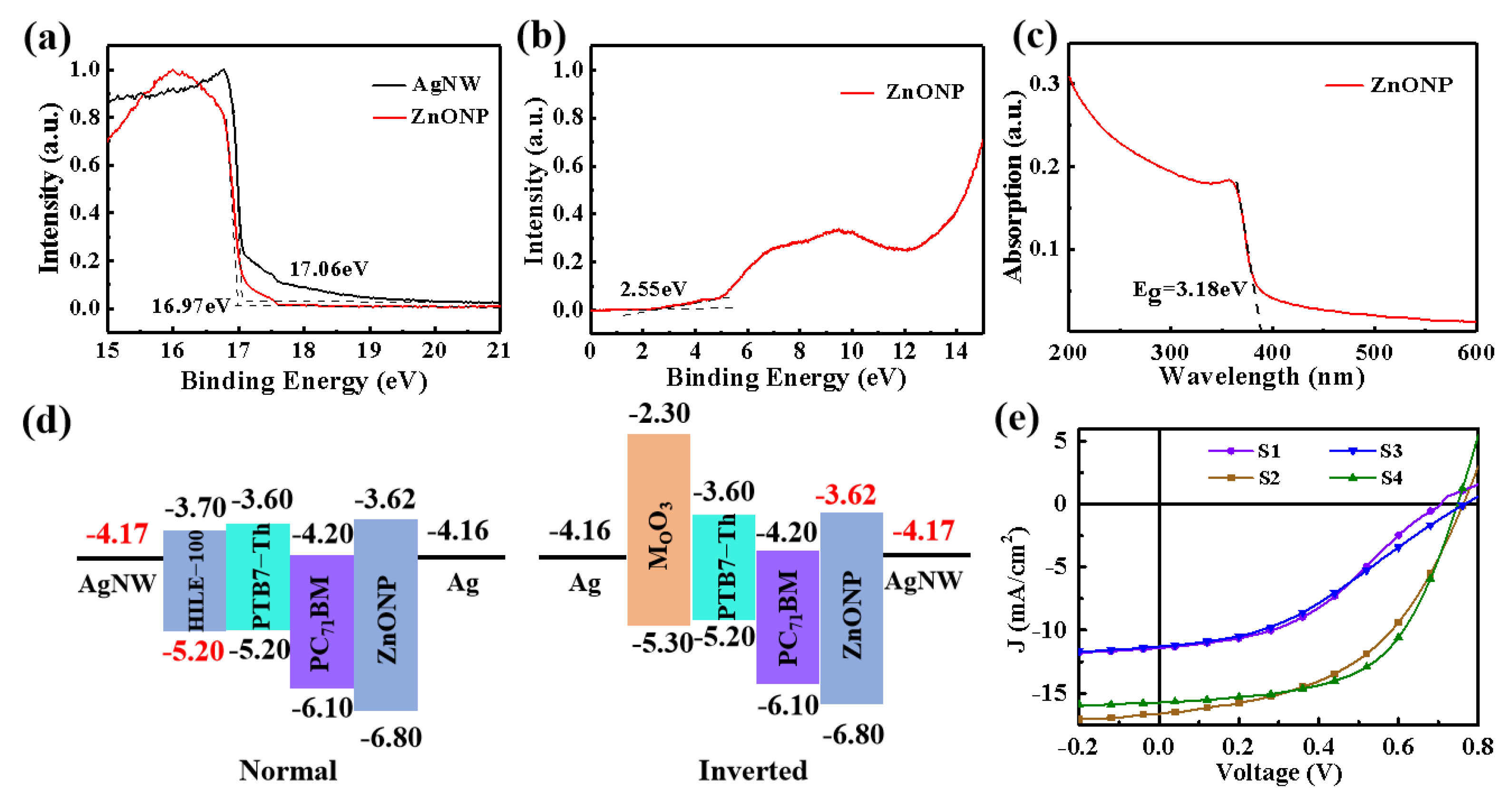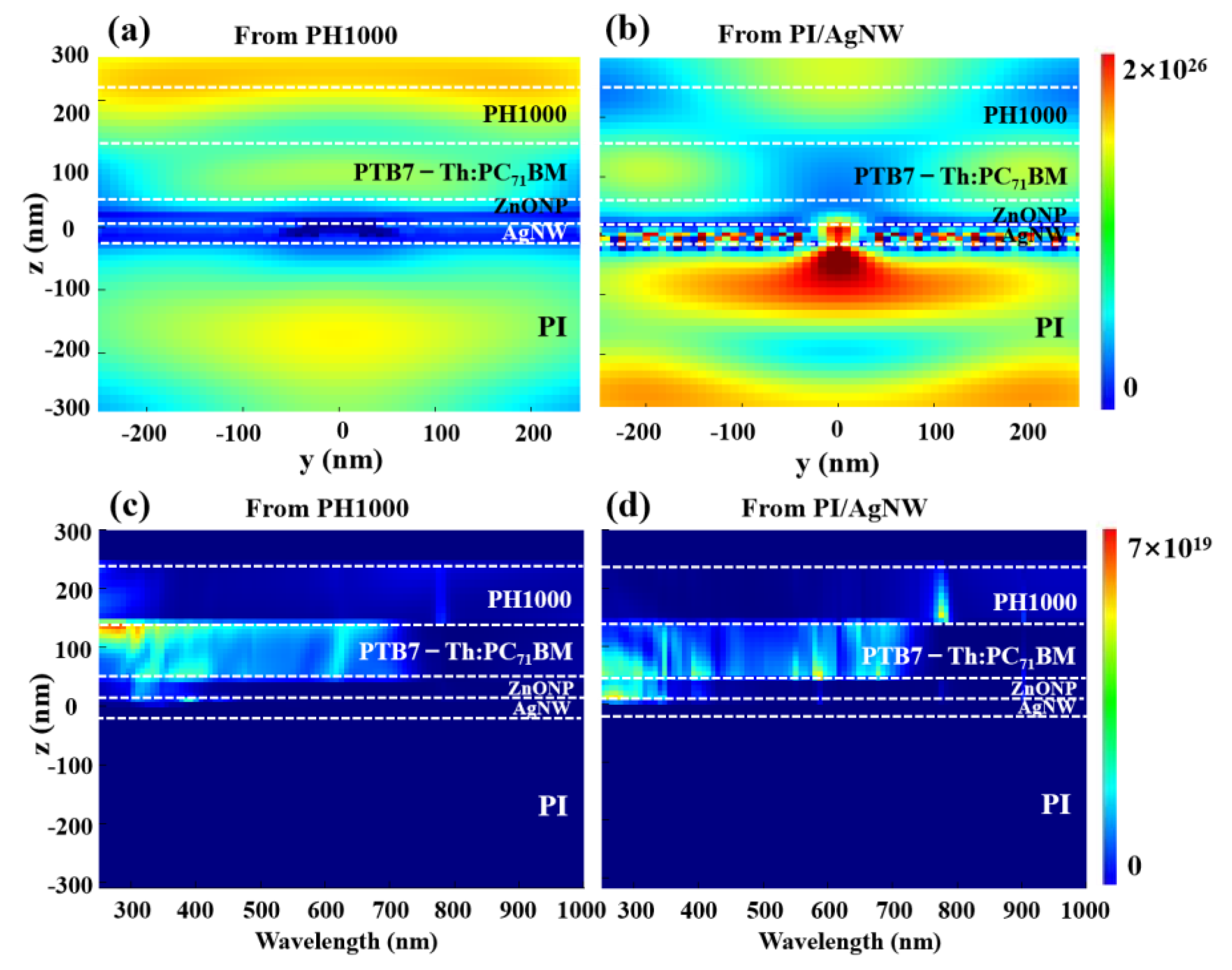Complete Solution-Processed Semitransparent and Flexible Organic Solar Cells: A Success of Polyimide/Ag-Nanowires- and PH1000-Based Electrodes with Plasmonic Enhanced Light Absorption
Abstract
:1. Introduction
2. Materials and Methods
3. Results and Discussion
4. Conclusions
Author Contributions
Funding
Conflicts of Interest
References
- Victoria, M.; Haegel, N.; Peters, I.M.; Sinton, R.; Jäger-Waldau, A.; del Cañizo, C.; Breyer, C.; Stocks, M.; Blakers, A.; Kaizuka, I.; et al. Solar photovoltaics is ready to power a sustainable future. Joule 2021, 5, 1041–1056. [Google Scholar] [CrossRef]
- Zhang, H.; Lu, Y.; Han, W.; Zhu, J.; Zhang, Y.; Huang, W. Solar energy conversion and utilization: Towards the emerging photo-electrochemical devices based on perovskite photovoltaics. Chem. Eng. J. 2020, 393, 124766. [Google Scholar] [CrossRef]
- Wang, L.; Yu, F.; Zhao, H.; Wang, Y.F.; Gu, T.F.; Su, W.Y.; Liang, Q.B.; Tang, Z.F.; Wu, H.B.; Hou, L.T. Impact of charge generation and extraction on photovoltaic performances of spin- and blade-as well as spray-coated organic solar cells. Org. Electron. 2022, 101, 106423. [Google Scholar] [CrossRef]
- Chen, J.; Tan, C.; Li, G.; Chen, L.; Zhang, H.; Yin, S.; Li, M.; Li, L.; Li, G. 2D silicon-based semiconductor Si2Te3 toward broadband photodetection. Small 2021, 17, 2006496. [Google Scholar] [CrossRef] [PubMed]
- Kreikemeyer-Lorenzo, D.; Hauschild, D.; Jackson, P.; Friedlmeier, T.M.; Hariskos, D.; Blum, M.; Yang, W.; Reinert, F.; Powalla, M.; Heske, C.; et al. Rubidium fluoride post-deposition treatment: Impact on the chemical structure of the Cu(In,Ga)Se2 Surface and CdS/Cu(In,Ga)Se2 interface in thin-film solar cells. ACS Appl. Mater. Interfaces 2018, 10, 37602–37608. [Google Scholar] [CrossRef] [PubMed] [Green Version]
- Yu, Y.; Tan, X.; Ning, S.; Wu, Y. Machine learning for understanding compatibility of organic–inorganic hybrid perovskites with post-treatment amines. ACS Energy Lett. 2019, 4, 397–404. [Google Scholar] [CrossRef]
- Chen, X.; Xu, G.; Zeng, G.; Gu, H.; Chen, H.; Xu, H.; Yao, H.; Li, Y.; Hou, J.; Li, Y. Realizing ultrahigh mechanical flexibility and >15% efficiency of flexible organic solar cells via a “welding” flexible transparent electrode. Adv. Mater. 2020, 32, 1908478. [Google Scholar] [CrossRef]
- Heo, S.W. Ultra-flexible organic photovoltaics with nanograting patterns based on CYTOP/Ag nanowires substrate. Nanomaterials 2020, 10, 2185. [Google Scholar] [CrossRef]
- Kim, I.K.; Jo, J.H.; Yun, J.H. Morphology-controlled high-efficiency small molecule organic solar cells without additive solvent treatment. Nanomaterials 2016, 6, 64. [Google Scholar] [CrossRef]
- Ju, H.; Park, D.; Kim, J. Solution-processable flexible thermoelectric composite films based on conductive polymer/SnSe0.8S0.2 nanosheets/carbon nanotubes for wearable electronic applications. J. Mater. Chem. A 2018, 6, 5627–5634. [Google Scholar] [CrossRef]
- Xu, G.; Shen, L.; Cui, C.; Wen, S.; Xue, R.; Chen, W.; Chen, H.; Zhang, J.; Li, H.; Li, Y.; et al. High-performance colorful semitransparent polymer solar cells with ultrathin hybrid-metal electrodes and fine-tuned dielectric mirrors. Adv. Funct. Mater. 2017, 27, 1701791. [Google Scholar] [CrossRef]
- Fan, X.; Xu, B.; Liu, S.; Cui, C.; Wang, J.; Yan, F. Transfer-printed PEDOT:PSS electrodes using mild acids for high conductivity and improved stability with application to flexible organic solar cells. ACS Appl. Mater. Interfaces 2016, 8, 14029–14036. [Google Scholar] [CrossRef]
- Kim, N.; Kang, H.; Lee, J.H.; Kee, S.; Lee, S.H.; Lee, K. Highly conductive all-plastic electrodes fabricated using a novel chemically controlled transfer-printing method. Adv. Mater. 2015, 27, 2317–2323. [Google Scholar] [CrossRef] [PubMed]
- Chen, S.; Li, H.; Zhao, K.; Wu, D. Preparation of graphene films bridged with Ag nanowires and its application in heterojunction solar cells. Sol. Energy 2020, 198, 167–174. [Google Scholar] [CrossRef]
- Zhu, L.; Wang, L.; Xue, F.; Chen, L.; Fu, J.; Feng, X.; Li, T.; Wang, Z.L. Piezo-photoronicphototropic effect enhanced flexible solar cells based on n-ZnO/p-SnS core-shell nanowire array. Adv. Sci. 2017, 4, 1600185. [Google Scholar] [CrossRef]
- Cui, M.; Zhang, X.; Rong, Q.; Nian, L.; Shui, L.; Zhou, G.; Li, N. High conductivity and transparency metal network fabricated by acrylic colloidal self-cracking template for flexible thermochromic device. Org. Electron. 2020, 83, 105763. [Google Scholar] [CrossRef]
- Huang, J.; Zhao, D.; Dou, Z.; Fan, Q.; Li, N.; Peng, S.; Liu, H.; Jiang, Y.; Yu, J.; Li, C.-Z. Highly efficient ITO-free organic solar cells with a column-patterned microcavity. Energ. Environ. Sci. 2021, 14, 3010–3018. [Google Scholar] [CrossRef]
- Fan, X. Doping and design of flexible transparent electrodes for high-performance flexible organic solar cells: Recent advances and perspectives. Adv. Funct. Mater. 2020, 31, 2009399. [Google Scholar] [CrossRef]
- Azani, M.R.; Hassanpour, A.; Torres, T. Benefits, problems, and solutions of silver nanowire transparent conductive electrodes in indium tin oxide (ITO)-free flexible solar cells. Adv. Energy Mater. 2020, 10, 2002536. [Google Scholar] [CrossRef]
- Zhang, J.; Xu, G.; Tao, F.; Zeng, G.; Zhang, M.; Yang, Y.M.; Li, Y.; Li, Y. Highly efficient semitransparent organic solar cells with color rendering index approaching 100. Adv. Mater. 2019, 31, 1807159. [Google Scholar] [CrossRef]
- Min, J.; Bronnbauer, C.; Zhang, Z.-G.; Cui, C.; Luponosov, Y.N.; Ata, I.; Schweizer, P.; Przybilla, T.; Guo, F.; Ameri, T.; et al. Fully solution-processed small molecule semitransparent solar cells: Optimization of transparent cathode architecture and four absorbing layers. Adv. Funct. Mater. 2016, 26, 4543–4550. [Google Scholar] [CrossRef]
- Guo, X.; Liu, X.; Lin, F.; Li, H.; Fan, Y.; Zhang, N. Highly conductive transparent organic electrodes with multilayer structures for rigid and flexible optoelectronics. Sci. Rep. 2015, 5, 10569. [Google Scholar] [CrossRef] [PubMed] [Green Version]
- Liu, Z.; Wang, T.; Nanda, S.S.; Yi, D.K.; Lee, E.-C. Plasmonic organic bulk-heterojunction solar cells based on hydrophobic gold nanorod insertion into active layers. J. App. Polym. Sci. 2018, 135, 45920. [Google Scholar] [CrossRef]
- Li, Q.; Chen, S.; Yang, J.; Zou, J.; Xie, W.; Zeng, X. High performance silicon/organic hybrid solar cells with dual localized surface plasmonic effects of Ag and Au nanoparticles. Solar RRL 2018, 2, 1800028. [Google Scholar] [CrossRef]
- Gan, Q.; Bartoli, F.J.; Kafafi, Z.H. Plasmonic-enhanced organic photovoltaics: Breaking the 10% efficiency barrier. Adv. Mater. 2013, 25, 2385–2396. [Google Scholar] [CrossRef]
- Wang, B.-Y.; Lee, E.-S.; Oh, Y.-J.; Kang, H.W. A silver nanowire mesh overcoated protection layer with graphene oxide as a transparent electrode for flexible organic solar cells. Rsc. Adv. 2017, 7, 52914–52922. [Google Scholar] [CrossRef] [Green Version]
- Chalh, M.; Vedraine, S.; Lucas, B.; Ratier, B. Plasmonic Ag nanowire network embedded in zinc oxide nanoparticles for inverted organic solar cells electrode. Sol. Energ. Mat. Sol. C 2016, 152, 34–41. [Google Scholar] [CrossRef]
- Li, R.; Zhang, K.; Chen, G. Highly transparent, flexible and conductive CNF/AgNW paper for paper electronics. Materials 2019, 12, 020322. [Google Scholar] [CrossRef] [Green Version]
- Hao, T.; Wang, S.; Xu, H.; Zhang, X.; Xue, J.; Liu, S.; Song, Y.; Li, Y.; Zhao, J. Stretchable electrochromic devices based on embedded WO3@AgNW core-shell nanowire elastic conductors. Chem. Eng. J. 2021, 426, 130840. [Google Scholar] [CrossRef]
- Sun, Y.; Du, Z. A flexible and highly sensitive pressure sensor based on AgNWs/NRLF for hand motion monitoring. Nano Mater. 2019, 9, 070945. [Google Scholar] [CrossRef]
- Seifrid, M.; Reddy, G.N.M.; Chmelka, B.F.; Bazan, G.C. Insight into the structures and dynamics of organic semiconductors through solid-state NMR spectroscopy. Nat. Rev. Mater. 2020, 5, 910–930. [Google Scholar] [CrossRef]
- Karki, A.; Wetzelaer, G.A.H.; Reddy, G.N.M.; Nádaždy, V.; Seifrid, M.; Schauer, F.; Nguyen, T. Unifying energetic disorder from charge transport and band bending in organic semiconductors. Adv. Funct. Mater. 2019, 29, 1901109. [Google Scholar] [CrossRef]
- Karki, A.; Vollbrecht, J.; Gillett, A.J.; Xiao, S.; Yang, Y.; Peng, Z.; Nguyen, T.-Q. The role of bulk and interfacial morphology in charge generation, recombination, and extraction in non-fullerene acceptor organic solar cells. Energy Environ. Sci. 2020, 13, 3679–3692. [Google Scholar] [CrossRef]
- Moradi, M.; Nayyeri, V.; Ramahi, O.M. An unconditionally stable single-field finite-difference time-domain method for the solution of maxwell equations in three dimensions. IEEE T. Antenn. Pro 2020, 68, 3859–3868. [Google Scholar] [CrossRef]
- Bai, X.; Wang, S.; Rui, H. Numerical analysis of finite-difference time-domain method for 2D/3D Maxwell’s equations in a cole-cole dispersive medium. Comput. Math. Appl. 2021, 93, 230–252. [Google Scholar] [CrossRef]
- Meagher, T.; Jiang, B.; Jiang, P. An enhanced finite difference time domain method for two dimensional Maxwell’s equations. Nume. Meth. Part. D E 2020, 36, 1129–1144. [Google Scholar] [CrossRef]
- Palik, E.D. Handbook of Optical Constants of Solids; Elsevier Inc.: Amsterdam, The Netherlands, 1997. [Google Scholar]
- Cheng, K.; Hu, J.P.; Wu, Y.C.; Shi, C.Q.; Chen, Z.G.; Liu, S.M.; Yuan, Y.C.; Mo, Y.Q.; Zhao, J.Q. Microwave-assisted synthesis of high thermal stability and colourless polyimides containing pyridine. Royal Soc. Open Sci. 2019, 6, 190196. [Google Scholar] [CrossRef] [PubMed] [Green Version]
- Yin, X.; Wang, J.; Liu, A.; Cai, W.; Ying, L.; He, X.; Tang, Z.; Hou, L. Flexible ITO-free sky-blue polymer light-emitting diodes and printed polymer solar cells based on AgNW/PI transparent conductive electrode. Flex. Print. Electron. 2020, 5, 014003. [Google Scholar] [CrossRef]
- Lin, Y.; Jin, Y.; Dong, S.; Zheng, W.; Yang, J.; Liu, A.; Liu, F.; Jiang, Y.; Russell, T.P.; Zhang, F.; et al. Printed nonfullerene organic solar cells with the highest efficiency of 9.5%. Adv. Energy Mater. 2018, 8, 1701942. [Google Scholar] [CrossRef] [Green Version]
- Cao, S.; Zheng, J.; Zhao, J.; Yang, Z.; Li, C.; Guan, X.; Yang, W.; Shang, M.; Wu, T. Enhancing the performance of quantum dot light-emitting diodes using room-temperature-processed Ga-doped ZnO nanoparticles as the electron transport layer. ACS Appl. Mater. Interfaces 2017, 9, 15605–15614. [Google Scholar] [CrossRef]
- Nascimento, A.C.S.; Lima, R.P.A.; Lyra, M.L.; Lima, J.R.F. Electronic transport on graphene armchair-edge nanoribbons with Fermi velocity and potential barriers. Phys. Lett. A 2019, 383, 2416–2423. [Google Scholar] [CrossRef]
- Wen, P.; Peng, R.; Song, W.; Ge, J.; Yin, X.; Chen, X.; Liu, C.; Zhang, X.; Ge, Z. A simple and effective method via PH1000 modified Ag-nanowires electrode enable efficient flexible nonfullerene organic solar cells. Org. Electron. 2021, 94, 106172. [Google Scholar] [CrossRef]





| Device | Optical Transparency | Incidence | VOC [V] | JSC [mA/cm2] | FF [%] | PCE [%] |
|---|---|---|---|---|---|---|
| S1 | No | PI/AgNW | 0.71 ± 0.02 | 11.40 ± 0.09 | 40.90 ± 0.06 | 3.32 ± 0.06 |
| S2 | No | PI/AgNW | 0.76 ± 0.01 | 16.63 ± 0.05 | 48.80 ± 0.08 | 6.17 ± 0.04 |
| S3 | No | ITO | 0.77 ± 0.02 | 11.29 ± 0.05 | 36.40 ± 0.09 | 3.14 ± 0.05 |
| S4 | No | ITO | 0.75 ± 0.01 | 15.74 ± 0.08 | 57.30 ± 0.09 | 6.76 ± 0.06 |
| S5 | Yes | PH1000 | 0.79 ± 0.01 | 10.21 ± 0.07 | 48.40 ± 0.05 | 3.88 ± 0.05 |
| PI/AgNW | 0.78 ± 0.02 | 8.30 ± 0.09 | 49.96 ± 0.08 | 3.23 ± 0.07 |
Publisher’s Note: MDPI stays neutral with regard to jurisdictional claims in published maps and institutional affiliations. |
© 2022 by the authors. Licensee MDPI, Basel, Switzerland. This article is an open access article distributed under the terms and conditions of the Creative Commons Attribution (CC BY) license (https://creativecommons.org/licenses/by/4.0/).
Share and Cite
Wang, J.; Liang, X.; Xie, J.; Yin, X.; Chen, J.; Gu, T.; Mo, Y.; Zhao, J.; Liu, S.; Yu, D.; et al. Complete Solution-Processed Semitransparent and Flexible Organic Solar Cells: A Success of Polyimide/Ag-Nanowires- and PH1000-Based Electrodes with Plasmonic Enhanced Light Absorption. Nanomaterials 2022, 12, 3987. https://doi.org/10.3390/nano12223987
Wang J, Liang X, Xie J, Yin X, Chen J, Gu T, Mo Y, Zhao J, Liu S, Yu D, et al. Complete Solution-Processed Semitransparent and Flexible Organic Solar Cells: A Success of Polyimide/Ag-Nanowires- and PH1000-Based Electrodes with Plasmonic Enhanced Light Absorption. Nanomaterials. 2022; 12(22):3987. https://doi.org/10.3390/nano12223987
Chicago/Turabian StyleWang, Jing, Xiangfei Liang, Jianing Xie, Xiaolong Yin, Jinhao Chen, Tianfu Gu, Yueqi Mo, Jianqing Zhao, Shumei Liu, Donghong Yu, and et al. 2022. "Complete Solution-Processed Semitransparent and Flexible Organic Solar Cells: A Success of Polyimide/Ag-Nanowires- and PH1000-Based Electrodes with Plasmonic Enhanced Light Absorption" Nanomaterials 12, no. 22: 3987. https://doi.org/10.3390/nano12223987





